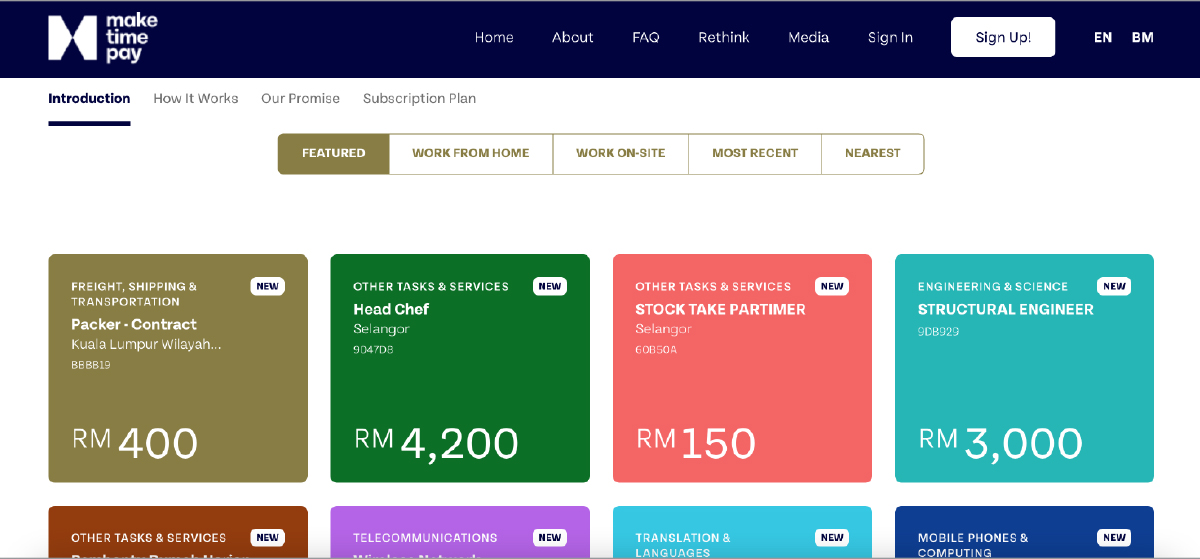
This article first appeared in Digital Edge, The Edge Malaysia Weekly on October 4, 2021 - October 10, 2021
The pandemic has seen an influx of professionals working in the ride-hailing and delivery sectors, as companies downsize to survive the pandemic. These professionals range from certified accountants and engineers to retirees from government agencies. This group of people has added to the already-dire employment conundrum in the country, where students are not able to secure jobs upon graduating.
Shahryn Azmi, executive director and co-founder of MakeTimePay, noticed this trend when one day, an elderly “uncle” with a background in accounting delivered food to him. “It’s the easiest thing to do …” was his reason, but this prompted Shahryn to take a deeper look into the gig economy.
The first problem, he realised, was not just the rate of unemployment in the country, but the rate of underemployment. The underemployed are individuals working at jobs they are overqualified for, just to make a buck or two to survive.
The next issue, he says, was the general perception of what constitutes a gig job as it tends to focus on those in the ride-hailing or delivery businesses. This perception was further cemented by media reports that conveniently used images of delivery riders in stories about the gig economy.
The general message these groups of people tend to receive is to upskill themselves with technology-focused disciplines, but Shahryn says while we need to acknowledge that tech has become an integral part of our lives, it does not mean that everyone needs to learn how to code.
“If all the 800,000 unemployed [people] became coders, the current Malaysian economy [would not be able to] absorb them in those roles. No economy in the world has all their workforce coding or programming in IT,” he explains.
“We know that there are skill shortages in the economy and if you have no technology background, it’s very hard for people to find a job. It’s very easy to tell someone to learn coding and programming but, realistically, how many people are actually willing to go down that road? Not many,” he says, adding that people are not willing to go into coding and tech because they do not have the aptitude for it, which is not necessarily their fault.
With the growth of the Fourth Industrial Revolution (IR 4.0), automation and digitisation will likely see a displacement of jobs. Thus, Shahryn says hiring needs a shift in perspective, specifically on people’s fixations on full-time positions, which causes them to lose income opportunities in the gig market. The first hurdle would be for both parties to embrace the concept of gig work and any kind of short-duration work that falls into this category.
“While including the images of ride-hailing and deliveries in this category is not wrong, gig is way beyond just that. Once that is understood, it opens up employers and workers to the concept of fractional employment, which will work well for both parties,” he says.
“The displacement of jobs due to automation is enormous. The International Labour Organization and McKinsey Global Institute estimate that 800 million people worldwide will lose their jobs by 2030 due to IR 4.0.”
Fractional employment is when a person works for many companies on a freelance basis instead of just one company, Shahryn explains. For example, a social media manager can handle the accounts of five different companies, where the workload is spread out over the week and the pay would be the same, or more, than that of a full-time role. Everyone wins as workers will have exposure to a company but they would not add to the company’s fixed overheads.
However, for this to happen, companies need a change in mindset and to be open to hiring multiple freelance experts to cover the workload of one job position, where the focus is on getting the job done and not on hiring one person to do it all. Headhunters are typically told to find “super people” to fill the vacancy, says Shahryn, but the reality is the people hired are usually great at only three out of five things that they are supposed to be recruited for.
For example, a recruiter sent out to hire an operations manager needs to find someone who is able to do finance, human resources, communications and risk management. Instead, companies could hire four separate people on a part-time basis to cover each area of expertise, while the operations manager manages the work done by them.
“When the operations manager comes in, he only needs to be good at coordination, best practices and give strategic input because he can manage these things, as opposed to doing [everything] himself,” says Shahryn.
The government could encourage fractionalisation, he adds, because it puts people of higher skills into slots specifically for those skills. In that situation, employers get to take on just the people who are able to get the specific task done. This method of hiring may also be able to save on hiring costs as well as ensure that the end result is of good quality.
“This is not rocket science. It’s something that’s actually being done in the rest of the world that’s not being done here. This is what is on demand right now, which is also a response to both Covid-19 and the onset of IR 4.0.”
Facilitating the gig economy
In a bid to reframe the employment landscape in Malaysia, Shahryn and several friends set up MakeTimePay, a website focused on gig work for all industries, skill sets and ranks. The website was launched in May after about a year of business and website development.
According to Shahryn, there are about 120,000 opportunities available on the website currently. The jobs listed cut across professions and skills, from coding to tailoring. The website runs on a freemium model, where users who are looking for jobs and companies looking to advertise vacancies can sign up and list for free.
For the payment of jobs, the site uses escrow to ensure those hired are paid on time. MakeTimePay gets payment into the worker’s bank account within 24 hours of the completion of the task, says Shahryn, as the main issue dogging gig work is employers welching on payment after the work is done.
“Escrow is only paid when the employer or company has confirmed the selection of an individual to do a job and the person has confirmed that he is still available to do the work he applied for. Posting the opportunity, therefore, is free,” he says. “We have a third-party payment gateway that receives that money; it doesn’t come to us. We charge a very small percentage on top of that and that’s how we make money.”
The website also employs a tri-level matching algorithm — qualification, interest and timing availability — to match companies with prospective workers. With its matching algorithm, Shahryn is hoping to optimise the job hunt process as well as reshape the employment landscape in Malaysia, which cannot be solved if only full-time jobs are advertised.
“We want to democratise work opportunities and disrupt the traditional hiring supply chain because we don’t see how the employment issue will be resolved, looking at the way the landscape is now,” he says.
Taking into consideration that some companies have reduced their workforce in the pandemic or imposed pay cuts, as well as the luxury of flexible work-from-home hours, the employment industry will definitely go through a transformation, Shahryn adds.
In 2005, he shares, a US Bureau of Labor Statistics study found that Americans changed careers at an average of seven times before retiring. In 2008, a similar study found that Malaysians change careers 2.98 times before they retire. In 2021, the Malaysian career change frequency must be greater than 3.0.
“There are so many more opportunities out there for people, constantly making it easier for them to be more creative and innovative in terms of what they [can] offer. People are going to explore and do different things and what’s exciting is that the system is starting to allow that to happen.”
Save by subscribing to us for your print and/or digital copy.
P/S: The Edge is also available on Apple's App Store and Android's Google Play.


